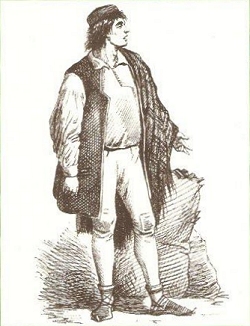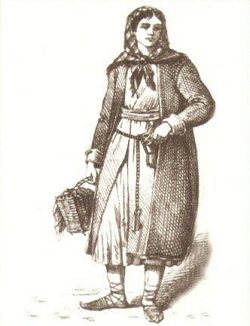[Tratto da: La Biblioteca del
Piccolo, [data?]
p. 27-29.]
The ciccio came from the mountains, from burnt and barren lands crossed only
by flocks of sheep and lambs and he was a Slavic [no,
slavicized Romanian] mountaineer with wide-brimmed hat, sleeveless chestnut grey
overcoat, tight grey trousers, white and flat slippers called opanche. He was
said to come from Cicceria or from the "land of the Cicci", locating this
plateau in the upper part of Istria, an area high above sea level and rich in
woods from which the cicci drew large quantities of firewood and soft coal .
The appellative cicci used to indicate the Romanians of the Carso, just as
cicerani
or ciribiri indicated those under Monte Maggiore, berchini those of the
Castelnuovo district, besiachi the Croats, fucki the peasants of Pìnguentino,
bodoli the islanders of Quarnero and maurovlahi the Dalmatians from the
mountains from the Poreč or Polesine countryside.
The figure of the ciccio
 |
|
Above and on the right, a ciccio and a ciccia from the series of costumes and
trades by Eugenio Bosa. |
|
|
 The ciccio arrived in
Trieste carrying with him heavy sacks containing the goods
to be sold, i.e. bundles of wood and soft coal. Shouting "Carbuna! Carbuna!
Fassi!" the
Trieste housewives flocked and the
ciccio began the sale, showing
them small samples of the various types of wood. Strong, resistant to cold, heat
and hunger, the ciccio reached the market squares, overcoming many difficulties
and remained there only for the time necessary to sell his products, to then
return with the small profit to his house hidden among the mountains. The Ciccio belonged to those Slavic[ized] Istrians who loved their
domestic independence, people who did not want to practice arts or professions
of any kind, but to continue the trade of their ancestors, handing it down from
generation to generation. In fact, they did not alter the uses and customs of
their own race, they never dressed, not even in winter, their right arm, which
remained covered only by the sleeve of the shirt, almost giving the impression
of being about to fight or ready for flight.
The ciccio arrived in
Trieste carrying with him heavy sacks containing the goods
to be sold, i.e. bundles of wood and soft coal. Shouting "Carbuna! Carbuna!
Fassi!" the
Trieste housewives flocked and the
ciccio began the sale, showing
them small samples of the various types of wood. Strong, resistant to cold, heat
and hunger, the ciccio reached the market squares, overcoming many difficulties
and remained there only for the time necessary to sell his products, to then
return with the small profit to his house hidden among the mountains. The Ciccio belonged to those Slavic[ized] Istrians who loved their
domestic independence, people who did not want to practice arts or professions
of any kind, but to continue the trade of their ancestors, handing it down from
generation to generation. In fact, they did not alter the uses and customs of
their own race, they never dressed, not even in winter, their right arm, which
remained covered only by the sleeve of the shirt, almost giving the impression
of being about to fight or ready for flight.
In
Trieste, the
ciccio was well liked and accepted, although his activity was
considered very humble by the people of
Trieste, perhaps the humblest of those
then exercised, so, with that witty and biting spirit that has always
distinguished the people of Tergesto, the people of
Trieste ironized a a little
about cicci and Cicceria and, having to give a negative judgment on a person
deemed incapable, they used to say: "Va la, bon de niente!
ciccio no xe per barca!", with a saying still very much in use today.
The ciccio carried out his business in that era that knew neither gas, nor
electricity, nor heating systems in houses, but only
fogoleri,
stue e forni a legna per la panificazione domestica.
The Slavic [Romanian] mountaineer sold coal but also wooden hoops,
handcrafted in winter; sometimes he was accompanied by a ciccia, his wife. The
woman carried large baskets full of vegetables, or wooden hoops on her
shoulders. The ciccia had a hemp cap on her head, opanks on her feet and
she wore a
knee-length overcoat that covered her heavy skirt and woolen socks.
The cicci were involved not only in the production of soft coal, but also in
sheep farming, in the transport of wine, salt and oil from the coast to the
inland areas of Carniola. The figure of the ciccio now belongs to another era,
almost to another world, the one in which our grandmothers and
great-grandmothers were intent on putting le spizze nelle stue (stoves) and
"sufiar su le bronze" because "el fogo ciapi" the
firewood, a world in which our
grandmothers and great-grandmothers ran swiftly into the street shouting:
"Carbuna! Carbuna e fassi!".